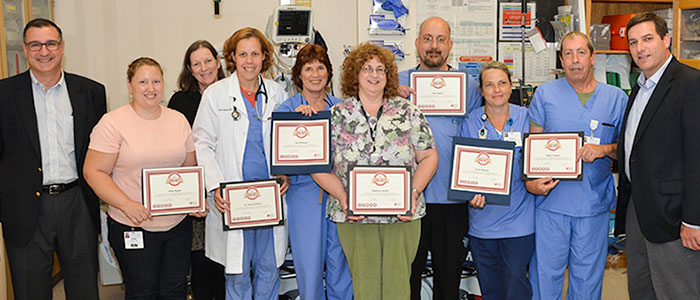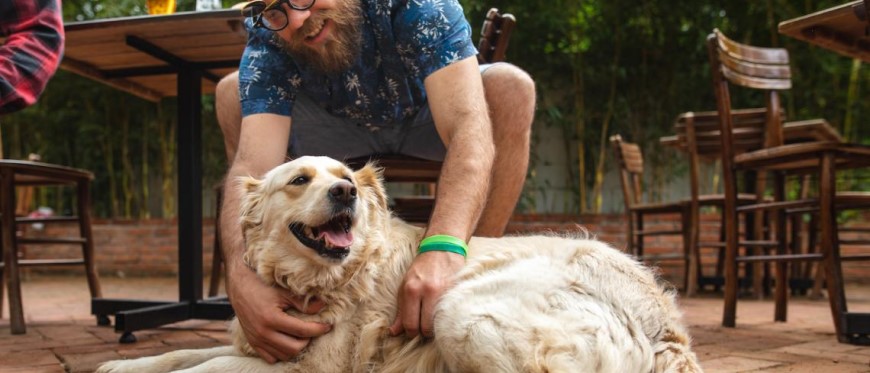Sudden Cardiac Arrest (SCA) is a condition in which the heart suddenly and unexpectedly stops beating. It is a leading cause of death among adults over the age of 40 in the United States. Of the approximately 424,000 people who suffer from sudden cardiac arrest outside of a hospital each year, only an estimated 10 percent survive.
So what are the survival rates of patients who experience sudden cardiac arrest in a hospital? Of the approximately 209,000 adults who go into cardiac arrest in-hospital, 23.9 percent of adults survive.
The staff in the Emergency Room at CVMC recently defied these odds, performing CPR for over an hour before resuscitating the patient, who today is expected to recover fully.

Shown above receiving award (l to r):Michael Palermo, American Heart Association; Holly Austin, RN; Pam Heffernan, RN; Kelvey Wilson, MD; Gail Williams, RN; Deanna Lanctot, RN; Ray Gasser, RN; Susan Becker, RN; Steve Folsom, CCT; and Michael Dickenson, American Heart Association.
Present on that day in the Emergency Room was Matthew Choate, RN, BSN, MBA, CEN, a per diem staff nurse in CVMC Emergency Department, where he has worked since 2003. His full time position is the Director of Emergency Services at Connecticut Children’s Medical Center in Hartford, CT. With family in Vermont and a love for clinical nursing, he has maintained his position at CVMC so he can still work when in Vermont.
Matthew was so impressed by the teamwork, the professionalism and the sheer perseverance of the team in the Emergency Room that it inspired him to write a letter (see below) to CVMC President and CEO, Judy Tartaglia.
As a result of this letter describing their efforts, the team in the Emergency Room received the “Heartsavers Hero Award” from the American Heart Association.
Letter from Matthew Choate, RN, BSN, MBA, CEN
[Note: This version has been edited.]
On Sunday, March 29, 2015, I was working the day shift (0700-1530) and was assigned to the “Code/Trauma” area of the CVMC Emergency Department.
On this particular afternoon, I was busy caring for two elderly gentlemen in A2 and A3 when a third patient was placed into the “Code Room/A1” and the charge nurse was triaging him for me.
Approximately 20 minutes passed and I saw the patient leave the code room to go for an X-Ray. The charge nurse indicated to me that the patient had been experiencing chest pain for 12 hours off and on, was currently without pain, had a normal EKG, and they were going to get a chest film.
Five minutes later, the patient came back to the code room on a stretcher with CPR in progress. I was told that the patient stood up for a chest film, became blue in the neck/face, and collapsed. The X-Ray Technologist caught the patient and put him on the floor, then summoned help. The patient was returned to the ED immediately.
Over the next 20-25 minutes, our ED team worked together to attempt to resuscitate this gentleman. After numerous rounds of medications, continued chest compressions, multiple defibrillation attempts, and other appropriate ACLS interventions, it seemed we were not going to resuscitate him.
We had a discussion about using thrombolytics in this case, as we suspected the underlying issue was either an MI (major heart-attack) or a Pulmonary Embolus (blood clot in the lung), both of which could respond to clot dissolving drugs. We elected to administer thrombolytic drugs and give them a chance to work.
Nearly 20-25 minutes later, the patient’s heart responded to the therapy and he regained a pulse and blood pressure. Over the next few minutes he began to take breaths on his own and a few minutes after that, began moving all of his extremities. We continued to work to stabilize the situation and made arrangements to transfer the patient to [UVM Medical Center]. As I write today, I understand he is breathing on his own, his brain is functioning well, and is expected to recover fully.
I wanted to share with you my impressions about the exemplary teamwork and professionalism that I witnessed that afternoon. I have been a nurse nearly twenty years in a variety of clinical and leadership positions. Good teamwork is what everyone strives for, but what I experienced was a model example of the highest degree of teamwork and care.
Everyone in the Emergency Department that day had a role in this successful resuscitation and I wanted you to know what an amazing, competent, professional team you have. I am honored and privileged to work with these folks.





